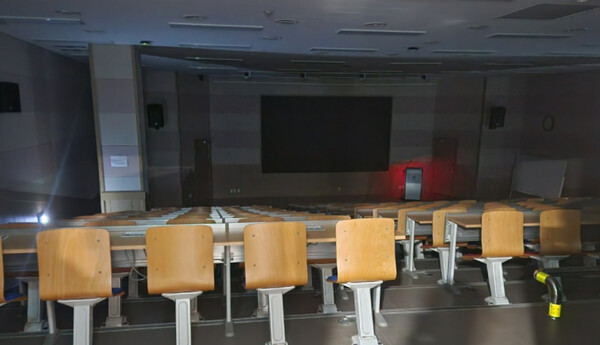Medical students are reportedly back in school, but classrooms are quiet.
Few medical students are likely to visit lecture halls for the time being, as many of those who have returned to school will likely continue their struggle by taking a leave of absence or boycotting classes.
On the first day after the end of the return period, it was difficult to find medical students on the campuses of medical colleges at Yonsei University and Seoul National University, among the first 40 medical schools in the country to take a leave of absence

The lecture halls at Yonsei University College of Medicine were mostly empty and unlit. There was no sign of professors or medical students, and the hallways were also deserted. The doors to the large lecture halls were securely locked, as was the medical library's study hall.
The situation was similar at Seoul National University College of Medicine. The only people walking in and out of the building were graduate students or students from the neighboring nursing school. These students said they had heard that the medical school had started but didn't know “if any medical students are coming to school.”
Classrooms and reading rooms were nearly empty, except for a few seats occupied by graduate students. The doors to the comprehensive labs were also locked.

According to university officials, both medical schools will continue to teach virtually until next week. Seoul National University College of Medicine has also reportedly changed some in-person classes that were offered when it opened last month to virtual ones.
“Last month, medical students who attended classes without taking a leave of absence were criticized, raising controversy. We switched to non-face-to-face for protection (of returning students) and will keep it for the time being,” a professor at Seoul National University College of Medicine told Korea Biomedical Review over the phone, requesting anonymity, on Tuesday. “This time, all SNU medical students have returned together, but there are still disagreements among the entire medical student community and the medical community over the enrollment decision, so I'm worried that (returning) medical students will be discouraged.”
Despite returning to school, students will continue to fight amid prolonged conflict
It's also unclear whether returning medical students will attend classes.

On Monday, Yonsei University College of Medicine's emergency committee informed medical students that “the direction of the struggle for the 2025 academic year is ‘leave of absence and refusal of classes.’”
A similar body at SNU College of Medicine also announced that it had switched the strike to a leave of absence after enrollment, saying it would provide action guidelines later.
Medical students at other universities who have decided to return to school have also vowed to continue their protest. In a letter to its members, the Korean Medical Students’ Association (KMSA) also united behind the principle of “unregistered leave of absence,” saying, “If we remain silent, today's threats will become tomorrow's standards and injustice will be justified.
However, the Ministry of Education emphasized that medical students must attend classes to be considered “reinstated.” In addition to suspension and expulsion for failure to return, some universities require returning students to pledge to attend classes to prevent them from taking a leave of absence or refusing to attend classes after enrollment.
“It is still unclear whether returning medical students will attend classes. The conflict within the medical community and on campus has not been completely resolved,” said a Yonsei University College of Medicine professor, wanting to remain anonymous. “There is a lot of backlash against the university and government's ‘strong-arm tactics’ through expulsion measures. I am worried that additional friction will arise while leaving enrollment or refusing classes.”
Another SNU College of Medicine professor requesting anonymity said, “I am very worried that the government and universities will continue to use coercive attitudes to turn students into ‘good listeners’ since the pressure has been applied once.”
The professor added that the government and universities should listen to the voices of returning medical students without attaching secondary conditions. The Korean Medical Association and faculty organizations should take action to protect medical students. No more damage should be done.
Related articles
- Yoon’s medical policy could falter if president is impeached on Friday: medical community
- Korean medical schools push last chance for students to return amid growing division
- Korea's public health doctor system on the brink of collapse
- Government claims medical student return rates are improving but schools remain tight-lipped
- SNU medical students’ decision to attend classes may signal a shift from conflict to comeback

